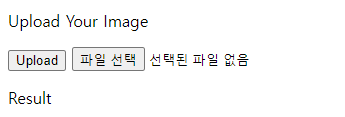Index
Tensorflow Serving ServerTensorflow Serving Client- Tensorflow Serving Application
Tensorflow Serving Application
이번 파트에서는 flask를 이용해서 간단한 웹 페이지를 만들어서 배포해보고 tensorflow serving과 통신하는 것까지 구현해 보도록 하겠다.
일단 간단하게 HTML 페이지를 작성해 보도록 하겠다.
1
2
3
4
5
6
7
8
9
10
11
12
13
14
15
16
17
18
| <body>
<p>Upload Your Image</p>
<form id="upload" action="/predict" method="POST" enctype="multipart/form-data">
<button class="btn">Upload</button>
<input type="file" value="Upload" name="image">
<br>
<p>Result</p>
{% if label %}
<span class="result">
{{ label }}
</span>
{% endif %}
</form>
</body>
|
귀찮아서 body만 가져왔다.
대충 이렇게 페이지를 짜주자. 왜냐면 메인은 이게 아니니깐.
그리고 다음과 같이 flask server를 구성해 보겠다.
1
2
3
4
5
6
7
8
9
10
11
12
13
14
15
16
17
18
19
20
21
22
23
24
25
| classes = ["airplane", "car", "bird", "cat", "deer", "dog", "frog", "horse", "boat", "truck"]
headers = {"content-type": "application/json"}
@app.route('/')
def index():
return render_template('index.html')
@app.route('/predict', methods=["POST"])
def predict():
data = request.files["image"].read()
image = Image.open(io.BytesIO(data))
image = image.convert("RGB")
image = image.resize((32, 32))
image = img_to_array(image)
image = np.expand_dims(image, axis=0)
image = np.asarray(image, dtype=np.uint8)
data = json.dumps({"signature_name": "serving_default", "instances": image.tolist()})
json_response = requests.post('http://localhost:8501/v1/models/ViT:predict', data=data, headers=headers)
print(json_response.text)
predictions = np.array(json.loads(json_response.text)["predictions"])
index = np.argmax(predictions[0])
return render_template("index.html", label=classes[index])
|
굉장히 심플하게 구성했다. 이제 서버를 구동해 주면 이미지를 띄울 수 있는 창이 뜨고 사진을 업로드 하면 inference 결과를 보여준다.

